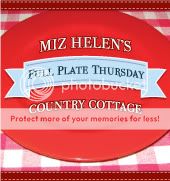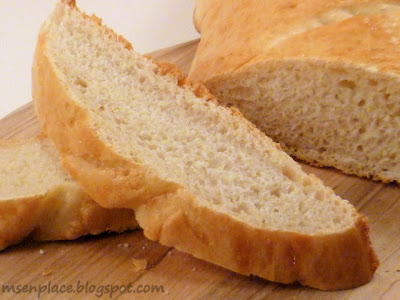
My most recent search for the perfect New Orleans French bread led me to a recipe titled "New Orleans Style French Bread."
Handed to me. On a plate. With butter even. Dontcha think?
I've been trying to achieve that soft, cottony on the inside, super-crisp, crackly on the outside bread served alongside gumbo and bisque and etouffee. Turned into po'boys stuffed with fat shrimp or dripping roast beef.
Check out this video--a Bill Geist/CBS this morning piece on Po'Boys (which, let's face it, is really all about the bread) to see what I'm after.
Don't have time to diddle through the Viagra ad or watch all 5:25 minutes?
Really, you can't give me that? Mile marker 2:23 will explain everything.
My current attempt at perfection comes from the cookbook Louisiana Lagniappe by Mercedes Vidrine.
The dough differs from the previous two French breads I've made because it uses shortening and has three--count them--three separate rising periods.
Now you know why I've been putting this recipe aside for a couple of months.
Since I was getting two loaves out of the deal, I decided to do a little experimenting I convinced myself that the egg white wash from Tony Chachere's recipe was what made his Hard Crust French Bread crusty. I brushed one loaf with egg wash and left the other alone. While the egg washed bread (on the right, above) did turn out crustier, it wasn't as crusty as Tony's Chachere's recipe.
I found the New Orleans Style French bread recipe to be too salty (but I think everything is too salty). It calls for 1 tablespoon of salt! The Boy's initial reaction was, "This is good bread." The Husband's suggestion was to use the Tony Chachere recipe, but increase the amount of salt to match today's recipe.
Keeping score?
Here's how the recipes rank so far.
Me:
1. (Best) Tony's Hard Crust French Bread
2. French Loaves
3. New Orleans Style French Bread
The Husband & the Boy are in agreement :
1. (Best) New Orleans Style French Bread (because of the amount of salt)
2. Tonys Hard Crust French Bread (for texture)
3. French Loaves
Printer Friendly
New Orleans Style French Bread
from Louisiana Lagniappe
2 Tbsp shortening
1 Tbsp sugar
1 Tbsp salt
1 cup boiling water
1 cup cold water
1 envelope active dry yeast
6-6 1/2 cups AP flour (I used 5)
Add the shortening, sugar, salt, and boiling water in a large mixing bowl or stand mixer and stir. Add the cold water and cool the mixture slightly to 105-115 degrees F.
Sprinkle the yeast over the mixture. Let stand for 5 minutes Stir to dissolve. Mix in 4 cups of the flour. Mix enough of the remaining flour to form a stiff dough.
Knead until dough is smooth and elastic--about 5 minutes. Place in a greased bowl and turn dough to grease the top. Cover with a damp cloth and let rise in a warm place until doubled in size (about 1-1 1/2 hours).
Punch dough down and let rise about 30 minutes.
Turn dough out onto a floured surface and knead slightly to press out gas bubbles. Divide in half. Shape each half into a long cylinder about as long as the diagonal of a large sheet pan. Place each loaf on a greased baking sheet. Let rise, uncovered, in a warm place until doubled in size (about 1-1 1/2 hours).
With a sharp knife, make 1/4" deep slashes in top of the dough. Bake in a moderate oven, 375 degrees F, for 45 minutes, or until nicely browned. Remove to cool on wire racks.
Linking with:
 |
 |
 |
|
 |
 | ||
 |
 |
 |



















Looks delicious! I think I'll have to pin this. I enjoy making bread-related products. :)
ReplyDeleteyou are on the road to perfecting it
ReplyDeleteI am impressed ! I think I would 1/2 the salt, or most times I omit from recipes, however bread you probably couldn't. I wish I could make bread as lovely as you. 3 x for rising? very time consuming.
ReplyDeleteThis comment has been removed by a blog administrator.
ReplyDeleteIt does look good, but interesting that it uses shortening.
ReplyDeleteThanks for sharing on Foodie Friday
The video has me thinking I need to plan a trip down there where I eat po'boys for breakfast, lunch, and dinner. There are so many variations!
ReplyDeleteAll that aside, I'm thinking you might want to try the Tony's version with a bit more salt. If you were to eat the bread plain then I can see it being a bit too salty. However, if you're perfecting the perfect loaf of french bread in order to make killer homemade po' boys then a saltier bread might be just the thing. By the time you fill the bread with the goods it might not taste very salty at all.
I definitely agree that there is something to the whole humidity/below sea factor concept. I also wonder if the water has something to do with it? You know how they say the NYC water makes the best pizza crust? Maybe the NOLA water makes for awesome french bread?
So now I'm laughing because I totally wrote a book. As if I'm an expert on bread making or something. Ha!
ReplyDeleteWhat I wonder is how I did not think to eat French bread while I was in NOLA! Guess I'll have to try a DIY version!
ReplyDeleteIt certainly looks GREAT !!
ReplyDeleteI love eating french bread with lots and lots of butter
okay... these are some pretty fine looking loaves... lots of air in 'em too and that's a good thing.
ReplyDeletenow, I still say it has something to do with the water, not meaning NOLA water but how the water is applied to the surface of the loaves toward the end of baking time... I mean, ya know the old trick of reheating a day old loaf by giving it a good splash of water over the top before it hits the oven makes for one fine, crusty loaf.. well, it just seems that would work toward the end of baking fresh bread too - but then, like I have told you before, I am not a baker... I must rely on the weekly truck that delivers Leidenheimer's golden loaves to us
Wow .... 1 tbsp of salt sounds like a lot to me too - but the proof is in, well, the bread! French Bread is one of my favorite breads to make because it is so easy and versatile to use! I would be curious of the outcome with your husband's suggestions :)
ReplyDeleteThanks for linking up at last week's Let's Get Social too :)
I loved the video about Po-boys I really have to get to New Orleans... what an institution and your French Bread sounds so different from what we have in NY. Thanks again for sharing your town and your food.
ReplyDeleteStumbled on this as I'm snowed in (again) this winter during Mardi Gras season and thought i'd make some NOLA French. The "Lagniappe" recipe sounds interesting, but I'm confused on something: when you first mention the recipe, you indicate that it has THREE rising periods, but the actual presentation of the recipe only has two. Is that the correct recipe? Did I miss a rise?
ReplyDeleteBe interesting to know if the NOLA bakers actually use shortening or lard. Now that I see the recipe, it makes sense, though, that shortening would combine with a lot of active yeast to make that fluffy inside we all know and love. The outside crust is typically from steam during the initial baking process--toss a cup or two of ice in the bottom of the oven when you put the loaves in to bake.
cleeland-there are 3 rises. After kneading,let rise, covered with a damp cloth for 1 to 1 1/2 hr. Punch down and let rise for about 30 min. After forming the loaves, the third rise is another 1-1 1/2 hrs. It's an all day thing. Perfect for being snowed in.
ReplyDelete...but sorry you are snowed in on Mardi Gras.
I've been putting a pan of water in the bottom of the oven to create steam. My husband uses a spray bottle of water to mist the inside of the oven every 10 minutes or so. The things we do to achieve that perfect loaf.